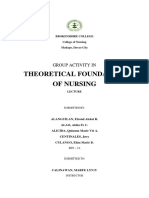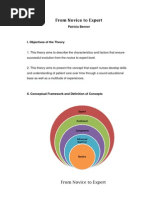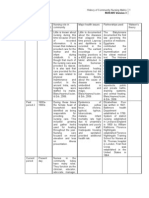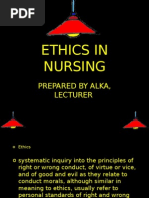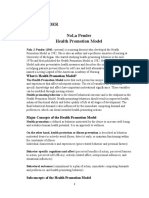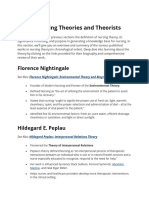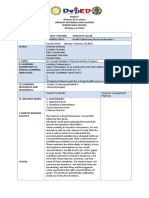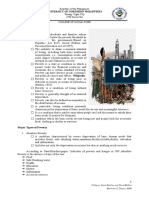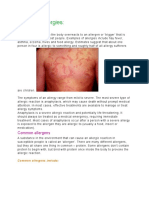Nola Pender's Health Promotion Model
Nola Pender's Health Promotion Model
Uploaded by
Ann PerezCopyright:
Available Formats
Nola Pender's Health Promotion Model
Nola Pender's Health Promotion Model
Uploaded by
Ann PerezCopyright
Available Formats
Share this document
Did you find this document useful?
Is this content inappropriate?
Copyright:
Available Formats
Nola Pender's Health Promotion Model
Nola Pender's Health Promotion Model
Uploaded by
Ann PerezCopyright:
Available Formats
Nola Pender and the Health Promotion Model
Nola Pender and the Health Promotion Model
Gerty N Cole
Concepts of Professional Nursing Practice NRSE 3400 College of Nursing ETSU
June 16, 2011
Nola Pender and the Health Promotion Model
1
Health promotion has been defined by the World Health Organization's 2005 Bangkok Charter for Health Promotion in a Globalized World as "the process of enabling people to increase control over their health and its determinants, and thereby improve their health." Health promotion has never been more important than it is in the present day. Nurses in education, practice, and research settings can participate in the advancement of health promotion not only to the mainstream but to the forefront of nursing practice. In the past, nurse educators have taught their patients how to manage illness; in the future, the focus is directed towards teaching people how to remain healthy. Nurses must have an evidence-based understanding of the significant effect that can be made through health promotion interventions and communicate this knowledge to the public at large. As more people grow in their awareness of activities and actions that lead to good health and become knowledgeable about their own health status and the health of their families, the overall health of the population will improve significantly. Dr. Nola J. Pender is Professor Emeritus in the School of Nursing at the University of Michigan. She developed the Health Promotion Model that is proposed as a holistic predictive model of health-promoting behavior for use in research and practice. This model has been tested internationally with varying health behaviors. Dr. Pender has published many research articles. One of her (Dr. Penders), current research focus is on testing the efficacy of a computerized physical activity counseling program for teenage and adolescent girls. Dr. Pender has authored a widely used text entitled, Health Promotion in Nursing Practice, (4th edition) which received the ANA Book of the Year Award for contributions to community health nursing. She has served as distinguished scholar at a number of universities.
Nola Pender and the Health Promotion Model
2
She received the distinguished alumni award from Michigan State University and holds an honorary doctoral degree from Widener University for her contributions to nursing research and health promotion. She has received many Distinguished Research Awards during the span of her nursing career. As the past-president of the American Academy of Nursing, Dr. Pender has also served as president of the Midwest Nursing Research Society. She served as a charter member of the National Advisory Council on Nursing Research. Currently, she is a member of the Board of Directors of Research! America, an organization committed to increasing public support for health research. Nola Pender consults nationally and internationally in health promotion and nursing research even in retirement. Dr. Nola J. Penders Health Promotion Model (HPM) (Pender, Murdaugh, & Parsons, 2006) that has been used in numerous studies to assess influences on health-promoting behaviors. These influencing factors are individual characteristics and experiences that includes prior related behaviors and personal factors. Personal factors fall into three categories: biological, psychological, and sociocultural. Biological factors include variables such as age and gender. Psychological factors include variables such as self-esteem, selfmotivation, and perceived health status. Sociocultural factors include such variables as race, educational level and ocioeconomic status (Pender et al., 2006). Other influences are behavior specific cognitions and affect, perceived benefits of action, perceived barriers to action, perceived self-efficacy and activity related affect. Specifically, the interpersonal influences of the HPM are cognitions regarding the behaviors, beliefs, or attitudes of others. Whether real or not, primary sources of interpersonal influences that affect decisions made regarding health
Nola Pender and the Health Promotion Model
3
promoting behaviors are family, peers and healthcare providers. In HPM, interpersonal interaction influences health-promoting behavior directly and indirectly through social pressures or encouragement to commit to a plan. The Health Promotion Model which was developed by Dr. Pender is used internationally for research, education, and practice. During her active research career, she conducted research testing on the Health Promotion Model with adults and adolescents. She also developed the program Girls on the Move with her research team and began intervention research into the usefulness of the model in helping adolescents adopt physically active lifestyles, developing a number of instruments that measure components of the model. The Health Promotion Model (HPM) proposed by Nola J Pender (1982; revised, 1996) was designed to be a complementary counterpart to models of health protection. It defines health as a positive dynamic state not merely the absence of disease. Health promotion is directed at increasing a clients level of well-being. This model (HPM), describes the multidimensional nature of persons as they interact within their environment to pursue health. The model focuses on following three areas: Individual characteristics and experiences, Behavior specific cognitions and affect, Behavioral outcomes. This model (HPM), notes that each person has unique personal characteristics and experiences that affect subsequent actions. The set of variables for behavioral specific knowledge and affect have important motivational significance. These variables can be modified through nursing actions. Health promoting behavior is the desired behavioral outcome and is the end point in the HPM. Health promoting behaviors should result in improved health, enhanced functional ability and better quality of life at all stages of development.
Nola Pender and the Health Promotion Model
4
The final behavioral demand is also influenced by the immediate competing demand and preferences, which can derail an intended health promoting act synthesizes research findings from nursing, psychology and public health into an explanatory model of health behavior that still must undergo further testing. The various health promotion strategies and tools that Dr. Pender has developed can be used as a basis for structuring nursing protocols and interventions. Nurses in practice should focus on understanding and addressing variables that are most predictive of given health behaviors (Pender, 1975). I am and have always been a strong advocate for health promotion and wellness. As a graduate of Public Health, my major interest in Nursing as a profession is to acquire the clinical skill, which will equip me towards contributing immensely to the health and wellness of the society. The importance of health promotion and prevention can never be over emphasized, all thanks to Dr, Pender and other scholars like her.
Nola Pender and the Health Promotion Model
5
Reference Kelley A.J., MSN, RN,. Sherrod R. A., DSN, RN., Smyth P., DSN, RN3, Coronary Artery Disease and Smoking Cessation Intervention by Primary Care Providers in a Rural Clinic. Online Journal of Rural Nursing and Health Care, vol. 9, no.2, Fall 2009 Marriner, T.A., Raile, A. M. (2005). Nursing theorists and their work (5th ed.). Sakraida T. Nola J. Pender. The Health Promotion Model. St Louis: Mosby Pender, N. J., Murdaugh, C., & Parsons, M.A. (2002). Health Promotion in Nursing Practice, (4th ed.). Upper Saddle River, NJ: Prentice-Hall Health, Inc. Pender, N.J., Murdaugh, C.L., & Parsons, M.A. (2006). Health Promotion in Nursing Practice (5th ed.). New Jersey: Pearson Prentice Hall. http://www.umich.edu/~bhlumrec/acad_unit/nurs/2003_87320/2003NURS/www.nursing.umich. edu/faculty/pender/pender_bio.html http://www.nursing.umich.edu/faculty-staff/nola-j-pender
You might also like
- Gerontological Nursing: Scope and Standards of Practice, 2nd EditionFrom EverandGerontological Nursing: Scope and Standards of Practice, 2nd EditionNo ratings yet
- Middle Range Theory of Chronic Sorrow PDFDocument15 pagesMiddle Range Theory of Chronic Sorrow PDFalda100% (1)
- Esmé Weijun Wang, The Collected Schizophrenias (2019)Document4 pagesEsmé Weijun Wang, The Collected Schizophrenias (2019)gghyo88No ratings yet
- Some Myths in Dentin Bonding An Evidence Based PerspectiveDocument7 pagesSome Myths in Dentin Bonding An Evidence Based PerspectiveCristian Aguilera100% (1)
- Nola Pender's Health Promotion ModelDocument23 pagesNola Pender's Health Promotion Modelclaricefritz100% (4)
- Focus On Nursing SEVENTH EDITION PharmacologyDocument2 pagesFocus On Nursing SEVENTH EDITION Pharmacologynanana100% (1)
- Henderson's ContributionsDocument3 pagesHenderson's ContributionsJULIANNE BAYHON100% (1)
- Anne Boykin and Savina O. SchoenhoferDocument16 pagesAnne Boykin and Savina O. SchoenhoferJammel Dayuday100% (1)
- Synthesis PaperDocument3 pagesSynthesis PaperCezanne Cruz100% (1)
- Sister Letty KuanDocument21 pagesSister Letty KuanMark Norriel CajandabNo ratings yet
- Quality Health Care and Nursing PDFDocument146 pagesQuality Health Care and Nursing PDFRyan Michael Oducado100% (5)
- Newman's Health As Expanding ConsciousnessDocument72 pagesNewman's Health As Expanding ConsciousnessJaymica Laggui Dacquil100% (3)
- Case StudyDocument3 pagesCase StudyLin LanNo ratings yet
- Faye Glenn Abdellah's Nursing TheoryDocument11 pagesFaye Glenn Abdellah's Nursing TheoryAnna Vanezza Dee100% (1)
- Running Head: Nursing Informatics Theory - Dikw 1Document6 pagesRunning Head: Nursing Informatics Theory - Dikw 1Patricia Havens ThomasNo ratings yet
- Picot PaperDocument16 pagesPicot Paperapi-24048640167% (3)
- EngagingWithVideogames PDFDocument300 pagesEngagingWithVideogames PDFfatmama7031100% (1)
- Theory Application of The Health Promotion Model KC 4Document8 pagesTheory Application of The Health Promotion Model KC 4api-269170045100% (2)
- Pender's TheoryDocument8 pagesPender's Theorycarendleon93% (15)
- Nola PenderDocument9 pagesNola PenderSheen Apon100% (2)
- 00 Health Promotion ModelDocument21 pages00 Health Promotion Modelapi-313117831100% (1)
- Penders Health Promotion ModelDocument7 pagesPenders Health Promotion ModelANIME SOLONo ratings yet
- Health Promotion Model By: Nola J. Pender: Presented By: Mila MaruyaDocument24 pagesHealth Promotion Model By: Nola J. Pender: Presented By: Mila MaruyaDon Chiaw Manongdo100% (1)
- Nola J. Pender's Health Promotion ModelDocument34 pagesNola J. Pender's Health Promotion Modeljay5ar5jamorabon5torNo ratings yet
- Health Promotion Model by Nola PenderDocument21 pagesHealth Promotion Model by Nola PenderGhen Canosa100% (2)
- Nursing Theories With ApplicationsDocument66 pagesNursing Theories With ApplicationsKaloy KamaoNo ratings yet
- Bioethics Film Review WITDocument3 pagesBioethics Film Review WITArienne_Mae_A__6554No ratings yet
- BennerDocument4 pagesBennerJane Febe CabatinganNo ratings yet
- Nursing Philosophies Patricia Benner Theory - Fuzna DM - I1J020010.id - enDocument10 pagesNursing Philosophies Patricia Benner Theory - Fuzna DM - I1J020010.id - enFuzna Dahlia100% (3)
- Nursing Informatics in TaiwanDocument3 pagesNursing Informatics in TaiwanKrishia HidalgoNo ratings yet
- Nursing Informatics in AsiaDocument12 pagesNursing Informatics in Asiaandrejenessy imperialNo ratings yet
- History of Community Health NursingDocument2 pagesHistory of Community Health NursingJennifer Finkley Gue100% (1)
- Novice To ExpertDocument26 pagesNovice To Expertsupermancokitty100% (2)
- Hildegard Peplau TheoryDocument28 pagesHildegard Peplau TheoryAlthea Grace AbellaNo ratings yet
- Teaching Plan DiarrheaDocument10 pagesTeaching Plan DiarrheaChristian Estrella67% (3)
- Nursing Trends Paper: Nursing InformaticsDocument6 pagesNursing Trends Paper: Nursing Informaticscwarrington09No ratings yet
- The Care, Core, Cure Theory - Lydia HallDocument3 pagesThe Care, Core, Cure Theory - Lydia HallEzraRamosLambarte0% (1)
- Assignment5.1 - Comfort Theory CritiqueFinalDocument8 pagesAssignment5.1 - Comfort Theory CritiqueFinalRacheal100% (1)
- AssignmentDocument4 pagesAssignmentBasema HashhashNo ratings yet
- Dorothy Johnson's TheoryDocument23 pagesDorothy Johnson's Theoryarielledy0405No ratings yet
- Florence Nightingale Environmental TheoryDocument11 pagesFlorence Nightingale Environmental TheoryLALRINTLUANGI CHHAKCHHUAK100% (1)
- Health Promotion Stress Management AssignmentDocument10 pagesHealth Promotion Stress Management Assignmentapi-211472021No ratings yet
- Evolution of The Nursing ProfessionDocument1 pageEvolution of The Nursing ProfessionDee BabieNo ratings yet
- Abdellah 21 Nursing ProblemsDocument7 pagesAbdellah 21 Nursing ProblemsKrizle AdazaNo ratings yet
- Ethics in NursingDocument17 pagesEthics in NursingLovely JacobNo ratings yet
- A.Nola Pender Nola Pender Health Promotion ModelDocument12 pagesA.Nola Pender Nola Pender Health Promotion ModelNathaniel PulidoNo ratings yet
- Unit 2 Evidence Based Nursing PracticeDocument94 pagesUnit 2 Evidence Based Nursing Practicenoo.wann100% (2)
- Psych Nursing EvolutionDocument50 pagesPsych Nursing EvolutionHershey Cordero Briones100% (2)
- List of Nursing Theories and TheoristsDocument16 pagesList of Nursing Theories and TheoristsPauline AñesNo ratings yet
- Nola PenderDocument17 pagesNola PenderGiorgetteNo ratings yet
- Ethics of Health Care (Not Full Book - 13 Pages)Document237 pagesEthics of Health Care (Not Full Book - 13 Pages)JelenaSindicNo ratings yet
- Nursing Leadership and Managment 2014 Modified NoteDocument365 pagesNursing Leadership and Managment 2014 Modified Notekidus asn100% (1)
- The Theory of Nursing As CaringDocument10 pagesThe Theory of Nursing As CaringMuhammad FurqanNo ratings yet
- Chapter 004Document21 pagesChapter 004HannaNo ratings yet
- Professional Accountability in NursingDocument4 pagesProfessional Accountability in NursingJohn N MwangiNo ratings yet
- Lydia Hall Nursing TheoryDocument1 pageLydia Hall Nursing TheoryJohn Patrick Bernada100% (1)
- Legal and Ethical Issues in NursingDocument14 pagesLegal and Ethical Issues in NursingRohini Rai0% (1)
- Hall 'S Care, Cure, Core Nursing TheoryDocument14 pagesHall 'S Care, Cure, Core Nursing TheoryRohanieNo ratings yet
- Nursing MetaparadigmDocument6 pagesNursing MetaparadigmFAITH HEIDI SALAZARNo ratings yet
- Nursing Core Competency Standards 2012Document35 pagesNursing Core Competency Standards 2012Roeder Cuerda100% (1)
- A Risky Journey 1Document10 pagesA Risky Journey 1Via Marie BatotoNo ratings yet
- AED 2020-Gruidebook For Nutritionat Treatment of Eating DisordersDocument63 pagesAED 2020-Gruidebook For Nutritionat Treatment of Eating DisordersNaiaraNo ratings yet
- Certain Traits Produce Certain Patterns of Behaviour. Patterns Are Consistent Across Different Situations. People Are "Born" With Leadership TraitsDocument3 pagesCertain Traits Produce Certain Patterns of Behaviour. Patterns Are Consistent Across Different Situations. People Are "Born" With Leadership TraitsAnkita KaundalNo ratings yet
- DRABCDocument2 pagesDRABCSam SankarNo ratings yet
- SPSC 2017 Paper Type ADocument19 pagesSPSC 2017 Paper Type AMeenaNo ratings yet
- Medicine and Doctoring in Ancient MesopotamiaDocument10 pagesMedicine and Doctoring in Ancient MesopotamiaRian LobatoNo ratings yet
- Anna's Insomnia Poster 2015Document1 pageAnna's Insomnia Poster 2015Anna KorompeliNo ratings yet
- Unoccupied Bed: ProcedureDocument7 pagesUnoccupied Bed: ProcedurechinztrolNo ratings yet
- Lesson 9 Government Programs and Suggestions in Addressing Social InequalitiesDocument25 pagesLesson 9 Government Programs and Suggestions in Addressing Social InequalitiesLeah Joy Valeriano-QuiñosNo ratings yet
- Contoh TTT1 Slide PresentationDocument17 pagesContoh TTT1 Slide PresentationNorazri NaaishamNo ratings yet
- A Symphonytic Review of Polyherbal Mouthwash For Efficitive Oral CareDocument5 pagesA Symphonytic Review of Polyherbal Mouthwash For Efficitive Oral CareInternational Journal of Innovative Science and Research TechnologyNo ratings yet
- Killing ComplacencyDocument3 pagesKilling Complacencytnks_1No ratings yet
- Certificate PDFDocument1 pageCertificate PDFSHADOWdragon YTNo ratings yet
- Energy Ball ExercisesDocument17 pagesEnergy Ball ExercisesMarlee KingNo ratings yet
- Hope 1 Module 7Document7 pagesHope 1 Module 7Karl Vincent DulayNo ratings yet
- Characteristics of An Inclusive ClassroomDocument2 pagesCharacteristics of An Inclusive Classroomapi-31685238175% (4)
- NCP FormatDocument1 pageNCP FormatNathaniel NograNo ratings yet
- Anna Smruti - Process-9Document6 pagesAnna Smruti - Process-9Mukesh SharmaNo ratings yet
- Oral HygieneDocument11 pagesOral HygieneIJAR JOURNALNo ratings yet
- Fallacies Class Exercise PDFDocument7 pagesFallacies Class Exercise PDFSimran BhatiaNo ratings yet
- SW 103 2nd Topic PDFDocument12 pagesSW 103 2nd Topic PDFMarielle BringasNo ratings yet
- Welcome To Personal DevelopmentDocument48 pagesWelcome To Personal DevelopmentFan of You100% (1)
- AllergiesDocument9 pagesAllergiesClark Angelo JuanNo ratings yet
- Disease Clinical Manifestation Diagnostic Test Medical & Surgical Management Nursing ManagementDocument1 pageDisease Clinical Manifestation Diagnostic Test Medical & Surgical Management Nursing Managementkristel_nicole18yahoNo ratings yet
- Argumentative EssayDocument3 pagesArgumentative EssayLea Delos SantosNo ratings yet
- Nurse As Educator Test BankDocument93 pagesNurse As Educator Test Bankjihan.080802100% (1)
- Lester LevensonDocument2 pagesLester Levensontlyra_29No ratings yet
























